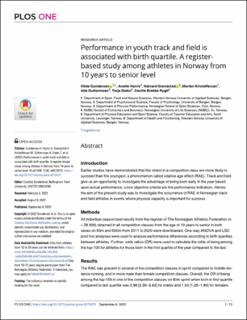| dc.contributor.author | Gundersen, Hilde | |
| dc.contributor.author | Harris, Anette Kristoffersen | |
| dc.contributor.author | Grendstad, Halvard | |
| dc.contributor.author | Kristoffersen, Morten | |
| dc.contributor.author | Guttormsen, Atle | |
| dc.contributor.author | Dalen, Terje | |
| dc.contributor.author | Rygh, Cecilie Brekke | |
| dc.date.accessioned | 2022-11-29T17:28:06Z | |
| dc.date.available | 2022-11-29T17:28:06Z | |
| dc.date.created | 2022-09-07T11:39:28Z | |
| dc.date.issued | 2022 | |
| dc.identifier.citation | PLoS ONE. 2022, 17(9), Artikkel e0273472. | en_US |
| dc.identifier.issn | 1932-6203 | |
| dc.identifier.uri | https://hdl.handle.net/11250/3034846 | |
| dc.description | This is an open access article distributed under the terms of the Creative Commons Attribution License, which permits unrestricted use, distribution, and reproduction in any medium, provided the original author and source are credited. | en_US |
| dc.description.abstract | Introduction: Earlier studies have demonstrated that the oldest in a competition class are more likely to succeed than the youngest, a phenomenon called relative age effect (RAE). Track and field give us an opportunity to investigate the advantage of being born early in the year based upon actual performance, since objective criteria are the performance indicators. Hence, the aim of the present study was to investigate the occurrence of RAE in Norwegian track and field athletes in events where physical capacity is important for success.
Methods: All individual season best results from the register of The Norwegian Athletics Federation (n = 28 999) obtained in all competition classes from the age of 10 years to senior in both sexes on 60m and 600m from 2011 to 2020 were downloaded. One-way ANOVA and LSD post hoc analyses were used to analyze performance differences according to birth quartiles between athletes. Further, odds ratios (OR) were used to calculate the odds of being among the top-100 for athletes for those born in the first quartile of the year compared to the last.
Results: The RAE was present in several of the competition classes in sprint compared to middle-distance running, and in more male than female competition classes. Overall, the OR of being among the top-100 in one of the competition classes on 60m sprint when born in first quartile compared to last quartile was 2.88 [2.30–3.62] for males and 1.54 [1.26–1.89] for females.
Conclusion: Being born early in the year in events with high demand for specific physical capacities is an advantage in both sexes in most of the youngest competition classes. In males, the advantage of being born early in the year lasted longer in sprint than in middle-distance running, indicating that puberty affects performance in sprint and middle-distance running differently. | en_US |
| dc.language.iso | eng | en_US |
| dc.subject | age groups | en_US |
| dc.subject | anthropometry | en_US |
| dc.subject | children | en_US |
| dc.subject | human performance | en_US |
| dc.subject | oxygen | en_US |
| dc.subject | puberty | en_US |
| dc.subject | running | en_US |
| dc.subject | sports | en_US |
| dc.title | Performance in youth track and field is associated with birth quartile: A register-based study among athletes in Norway from 10 years to senior level | en_US |
| dc.type | Peer reviewed | en_US |
| dc.type | Journal article | en_US |
| dc.description.version | publishedVersion | en_US |
| dc.rights.holder | © 2022 Gundersen et al. | en_US |
| dc.source.pagenumber | 12 | en_US |
| dc.source.volume | 17 | en_US |
| dc.source.journal | PLoS ONE | en_US |
| dc.source.issue | 9 | en_US |
| dc.identifier.doi | 10.1371/journal.pone.0273472 | |
| dc.identifier.cristin | 2049438 | |
| dc.description.localcode | Institutt for fysisk prestasjonsevne / Department of Physical Performance | en_US |
| dc.source.articlenumber | e0273472 | en_US |
| cristin.ispublished | true | |
| cristin.fulltext | original | |
| cristin.qualitycode | 1 | |
